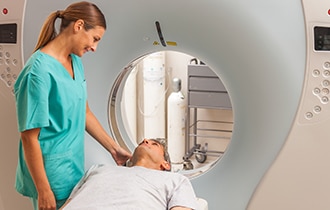Diagnosis of Pancreatitis
How do doctors diagnose pancreatitis?
To diagnose pancreatitis and find its causes, doctors use
- your medical history
- a physical exam
- lab and imaging tests
A health care professional will ask
- about your symptoms
- if you have a history of health conditions or concerns that make you more likely to get pancreatitis—including medicines you are taking
- if you have a personal or family medical history of pancreatitis or gallstones
During a physical exam, the health care professional will
- examine your body
- check your abdomen for pain, swelling, or tenderness

What tests do health care professionals use to diagnose pancreatitis?
Health care professionals may use lab or imaging tests to diagnose pancreatitis and find its causes. Diagnosing chronic pancreatitis can be hard in the early stages. Your doctor will also test for other conditions that have similar symptoms, such as peptic ulcers or pancreatic cancer.
Lab tests
Lab tests to help diagnose pancreatitis include the following:
Blood tests. A health care professional may take a blood sample from you and send the sample to a lab to test for
- high amylase and lipase levels—digestive enzymes made in your pancreas
- high blood glucose, also called blood sugar
- high levels of blood fats, called lipids
- signs of infection or inflammation of the bile ducts, pancreas, gallbladder, or liver
- pancreatic cancer
Stool tests. Your doctor may test a stool sample to find out if a person has fat malabsorption.
Imaging tests
Health care professionals also use imaging tests to diagnose pancreatitis. A technician performs most tests in an outpatient center, a hospital, or a doctor’s office. You don’t need anesthesia, a medicine to keep you calm, for most of these tests.
Ultrasound. Ultrasound uses a device called a transducer, which bounces safe, painless sound waves off your organs to create a picture of their structure. Ultrasound can find gallstones.
Computed tomography (CT) scan. CT scans create pictures of your pancreas, gallbladder, and bile ducts. CT scans can show pancreatitis or pancreatic cancer.
Magnetic resonance cholangiopancreatography (MRCP). MRCP uses a magnetic resonance imaging (MRI) machine, which creates pictures of your organs and soft tissues without x-rays. Your doctor or a specialist may use MRCP to look at your pancreas, gallbladder, and bile ducts for causes of pancreatitis.

Endoscopic ultrasound (EUS). Your doctor inserts an endoscope—a thin, flexible tube—down your throat, through your stomach, and into your small intestine. The doctor turns on an ultrasound attachment to create pictures of your pancreas and bile ducts. Your doctor may send you to a gastroenterologist to perform this test.
Pancreatic Function Test (PFT). Your doctor may use this test to measure how your pancreas responds to secretin, a hormone made by the small intestine. This test is done only at some centers in the United States.
This content is provided as a service of the National Institute of Diabetes and Digestive and Kidney Diseases
(NIDDK), part of the National Institutes of Health. NIDDK translates and disseminates research findings to increase knowledge and understanding about health and disease among patients, health professionals, and the public. Content produced by NIDDK is carefully reviewed by NIDDK scientists and other experts.
The NIDDK would like to thank:
Christopher E. Forsmark, M.D., University of Florida College of Medicine

